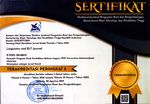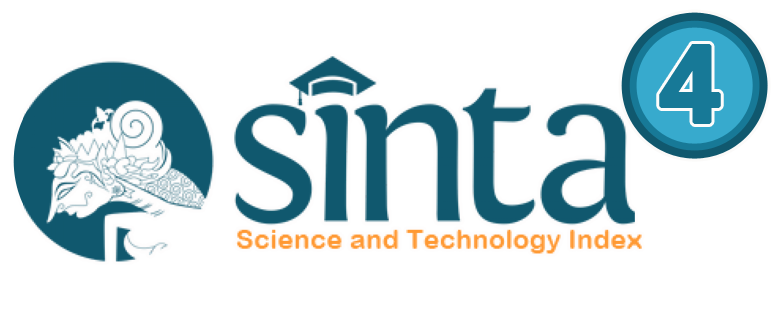Collaborative Model in Teaching Linguistics (A Grounded Theory Study at Universitas Borneo Tarakan)
Abstract
Keywords
Full Text:
PDFReferences
S. Hariyanto, “Tren Kajian Terjemahan dan Industri Terjemahan,” J. Linguist. Terap., vol. 7, no. 1, pp. 1–9, 2017.
S. Ku and S. Ünlü, “Teaching translation : A suggested lesson plan on translation of advertising through the use of authentic materials,” vol. 199, pp. 407–414, 2015, doi: 10.1016/j.sbspro.2015.07.526.
E. Nida, Contexts in Translating. Amsterdam: John Benjamins Publishing Company, 2001.
A. Karimnia, “Undergraduate translation training : In search of a model,” Procedia - Soc. Behav. Sci., vol. 70, pp. 915–921, 2013, doi: 10.1016/j.sbspro.2013.01.138.
M. Azizinezhad and M. Hashemib, “Teaching translation courses, back to basics, desirable or not?,” Procedia - Soc. Behav. Sci., vol. 28, pp. 426–429, 2011, doi: 10.1016/j.sbspro.2011.11.081.
K. Johnson, David, W., Johnson, Roger, T., & Smith, Cooperative Learning: Increasing Collage Faculty Instructional Productivity. 1991.
Kiraly, “Summary of discussion on collaboration, teamwork and group work. Innovation and E Learning p.51-57,” 2000.
E. H. Barros, “Collaborative learning in the translation classroom: preliminary survey results,” no. 16, pp. 42–60, 2011.
H. Lee-jahnke, “Interdisciplinary approach in translation didactics,” Riv. internazionale di Tec. della traduzione., pp. 1–12, 2011.
S. Bonvallet, J. De Luce, S. Bonvallet, and J. De Luce, “Roles for Technology in Collaborative Teaching Roles for Technology in Collaborative Teaching,” vol. 18, no. 2, pp. 295–303, 2019.
M. Cem and S. Kokturk, “The effects of technology on translation students in academic translation teaching,” Procedia - Soc. Behav. Sci., vol. 197, no. February, pp. 1085–1094, 2015, doi: 10.1016/j.sbspro.2015.07.349.
R. . Keyes, C. S., Puzio, Kelly., & Jimenez, “Collaborative Translations : Designing Bilingual Instructional Tools,” J. Educ. Vol. 194, No. 2, vol. 194, no. 2, pp. 17–24, 2019.
C. La Rocca, M. Margottini, and R. Capobianco, “Collaborative Learning in Higher Education,” no. February, pp. 61–66, 2014.
M. Aderi, C. Noh, S. Andayani, and M. Yusuf, “Collaborative Learning Technique within Higher Learning Education Students,” Creat. Educ., vol. 9, pp. 2367–2375, 2018, doi: 10.4236/ce.2018.914177.
K. Puzio and G. T. Colby, “Journal of Research on Educational Cooperative Learning and Literacy : A Meta-Analytic Review Cooperative Learning and Literacy : A Meta-Analytic Review,” vol. 6:4, no. December 2014, pp. 37–41, 2013, doi: 10.1080/19345747.2013.775683.
D. August and T. Shanahan, “English Language Learners : Developing Literacy in Second-Language Learners — Report of the National Literacy Panel on Language-Minority Children and Youth,” J. Lit. Res., vol. 41, pp. 432–452, 2009, doi: 10.1080/10862960903340165.
R. E. Slavin and A. Cheung, Effective Reading Programs for English Language Learners A Best-Evidence Synthesis, vol. 66. 2003.
F. Genesee, K. Lindholm-leary, W. Saunders, and D. Christian, “English Language Learners in U . S . Schools : An Overview of Research Findings,” vol. 10, no. 4, pp. 363–385, 2005.
E. Learners and R. Gersten, “What we Know About Effective Instructional Practices for,” vol. 66, no. 4, pp. 454–470, 2000.
P. M. Lightbown, “Anniversary Article Classroom SLA Research and Second Language Teaching,” pp. 431–462, 2000.
N. Taguchi, “Collaborative Dialogue in Learning Pragmatics : Pragmatic-Related Episodes as an Opportunity for Learning Request-Making,” no. January 2016, 2017, doi: 10.1093/applin/amu039.
N. Zarrinabadi and A. Ebrahimi, “Increasing peer collaborative dialogue using a flipped classroom strategy,” Innov. Lang. Learn. Teach., vol. 0, no. 0, pp. 1–10, 2018, doi: 10.1080/17501229.2018.1455688.
A. Ammar and R. M. Hassan, “Talking It Through : Collaborative Dialogue and Second language Learning,” a J. Res. Lang. Stud., pp. 1–37, 2017, doi: 10.1111/lang.12254.
A. Baradaran and M. Moezzy, “A Study of the Role of Collaborative Negotiation in the Acquisition of Lexical Meaning,” Aust. J. Basic Appl. Sci., vol. 5, no. 12, pp. 2252–2259, 2011.
M. W. Cole, “Rompiendo el Silencio : Meta-Analysis of the Effectiveness of Peer-Mediated Learning at Improving Language Outcomes for ELLs,” Biling. Res. J. J. Natl. Assoc. Biling. Educ., vol. 36, no. August 2014, pp. 37–41, 2013, doi: 10.1080/15235882.2013.814609.
R. Haydan, “*Graduated in 22 February 2013 from English Education Study Program of Indonesia University of Education,” J. English Educ., no. 2007, pp. 57–64, 2013.
C. Urquhart, Grounded Theory for Qualitative Research: A Practical Guide. SAGE Publications, 2022.
K. Charmaz, Constructionism anf The Grounded Theory Method. 2000.
S. Gasson and J. Waters, “Using A Grounded Theory Approach To Study Online Collaboration Behaviors *,” Eur. J. Inf. Syst., vol. 22, pp. 95–118, 2013.
R. Thornberg, “A Grounded Theory of Collaborative Synchronizing in Relation to Challenging Students,” SAGE Publ., no. 47, pp. 312–342, 2012.
M. Birks and J. Mills, GROUNDED THEORY. SAGE Publication Ltd, 2015.
I. Nurjannah, J. Mills, T. Park, and K. Usher, “Conducting a Grounded Theory Study in a Language Other Than English : Procedures for Ensuring the Integrity of Translation,” SAGE Open, pp. 1–10, 2014, doi: 10.1177/2158244014528920.
J. Corbin and A. Strauss, “Grounded Theory Research : Procedures , Canons , and Evaluative Criteria,” J. Qual. Sociol., vol. 13, no. 1, 1990.
Emzir, Metodologi Penelitian Kualitatif: Analisis Data Jakarta. Jakarta: Raja Grafindo, 2010.
J. W. Creswell and C. N. Poth, “Qualitative inquiry and research design (international student edition): Choosing among five approaches,” Language (Baltim)., vol. 25, no. 459p, p. 23cm, 2018.
DOI: https://doi.org/10.31764/leltj.v12i2.28379
Refbacks
- There are currently no refbacks.
Copyright (c) 2024 Syarifa Rafiqa, Nofvia De Vega

This work is licensed under a Creative Commons Attribution-ShareAlike 4.0 International License.
_____________________________________________________
Linguistics and ELT Journal
p-ISSN 2339-2940 | e-ISSN 2614-8633

LELTJ is licensed under a Creative Commons Attribution-ShareAlike 4.0 International License.
_____________________________________________________
LELTJ is abstracting & indexing in the following databases:
_____________________________________________________
LELTJ Editorial Office:













